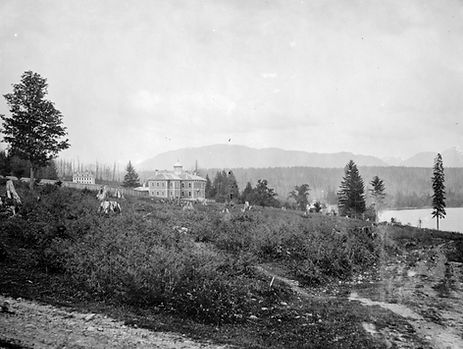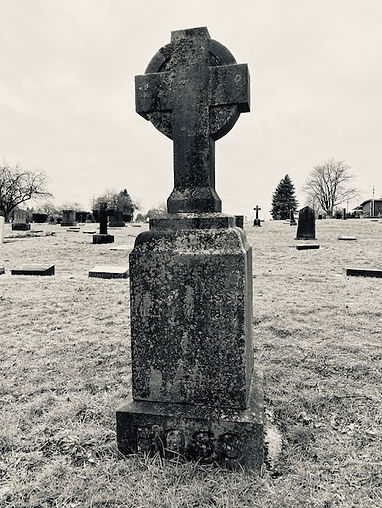
IV. The New Westminster Years:
CHAPTER LINKS:
I. From Childhood to Marriage
II. The San Juan Island Years
III. The Early Asylum Years
In May of 1878, Flora and her colleagues transferred forty-six patients to the new Provincial Asylum for the Insane in New Westminster. Although the building was brand new, it was described from the outset as poorly designed and far too insufficient. The building contained thirty-two single rooms for patients, with an instant population of forty-six.
Prior to her departure from Victoria, Flora made arrangements for Isabella, who at the time was referred within the family as “Granny,” to live at the Sisters of St.
Ann’s convent in the small log cabin that had once been Flora’s schoolroom, for a monthly fee of $15.00 per month. Her son Charles, now sixteen, accompanied Flora and appears to have continued to reside with her at the new asylum. Records from the Royal Columbian Hospital show that he was a patient that fall with Scarletina, and describe him as being sixteen, single, born on San Juan Island, and occupied as a “Clerk.” One of Charles’ cousins, Isabelle Wren, describes him in a letter to her sister in December of 1878 as having grown into a tall and handsome fellow.
In 1883 a provincial commission was appointed to conduct a report on the operations of the asylum. It reported that the institution resembled “a prison rather than a hospital for the insane, and was a far less preferable place of abode than the Penitentiary at New Westminster.” It also noted that the patients were “herded together more like cattle than human beings.” The report made a variety of recommendations for improvements, including a permanent onsite physician, an enlarged building, various physical improvements, and even details such as pictures on the walls. One result of the report was that Flora was able to hire her first assistant so that she, alone, was not responsible for the care of the female patients. And in 1884 a new wing was added to the asylum.
Isabella passed away in 1885, and the Colonist reports that Flora was by her side. Family letters throughout this period show that Flora maintained a close relationship with her nieces, the daughters of her elder sister, Elizabeth Wren, who became the step-daughters of her sister, Mary, after Mary married Elizabeth’s widowed husband, Charles Wren. It was Flora, however, rather than Mary, who appears from the surviving family letters (and the nieces’ descriptions of both women) to have maintained the close familial bond. One of Flora’s nieces describes in a letter to her sister that she had received a letter from Flora stating that she intended to take a month off from work, for her first real vacation, and that she intended to travel to Portland (where this niece lived) and then to the Rocky mountains. Given
that the CPR was not yet operational through the Canadian Rockies, it’s likely that she travelled through the U.S., if she achieved her goal.
Although Flora worked as a nurse in her younger years, she reported near the end of her career that she had never received any instructions for the care of mentally ill patients. In the late 1880’s, she travelled south to tour the Salem asylum in Oregon, and the Steilacoom asylum in Washington State, as a means to learn about standards and methods of care in those institutions. It appears to have been a working trip, as an article in the Colonist reports the following year that she was enjoying her second vacation in five years, by spending time in Victoria to visit old friends. The article tells the story of her patients throwing their slippers at the door as she left, as an apparent offering of good luck. A similar visit three years later was recorded by the Colonist’s personals column in the following manner:
Mrs. Ross, matron of the Lunatic Asylum, is in the city visiting her friends. She looks as fresh and as young as ever and is as cheerful as if taking care of the insane were the most inspiring of occupations. Mrs. Ross is devoted to her patients. She is doing a good work and doing it well.
See British Colonist, January 19, 1893, p. 8. The idea of vacations appeared to become somewhat more accepted by this time, as Flora recounted in 1894 that she had taken a trip to San Francisco earlier that year. Depending upon whether or not her visit to the Rockies had been successful in 1885, her trip to San Francisco may have been her farthest journey from home during her lifetime, and was likely the largest city she ever visited.
A second Royal Commission was appointed to investigate the methods of care at the asylum in 1894, and it issued its report late that year, complete with testimony provided by Flora. She recounts how, from the outset of her employment in 1870, she had attempted to use as little restraint as possible on any patients, and solely when necessary for their own safety, and that she would have refused instructions to use traditional restraints from the men’s side of the asylum such as a straightjacket on her patients. She describes how she invented a more gentle version of a straightjacket—a restraining camisole made out of a man’s shirt—in response to a patient who used to “knaw her arm – bite her arm and bleed – almost take pieces out of it.” She further explains that she tried out the various designs for the camisole on herself, so that she would know how a patient would feel when being forced to wear one. Though it’s a tale that suggests methods that
are out of place with current standards of care, it also demonstrates Flora’s commitment to improving the conditions of her patients given the standards of her time.
The Royal Commission report routinely describes Flora’s care of her patients in terms that placed it far above the standards of care for the male patients, such as:
The female patients at time repair to the recreation hall upstairs, which is furnished with a piano, and decorated gayly with the flags of all nations, the work of the patients themselves, under the direction of the Matron. Here they dance to music supplied by one of their number at the piano. We witnessed one of these entertainments, and were favourably impressed with the good order maintained, and with the efforts of the Matron and her assistants to brighten the lot of the patients under their charge.
See Report of Royal Commission, November 27, 1894.
Flora was diagnosed with terminal cancer in late 1896, while she still lived at the asylum and worked as its Matron. Her son Charles, by this time an adult, was living in the Kootenay region of the province, working as a miner. Flora continued to fulfill her duties as Matron until the final weeks of her life. She passed away in her room at the asylum on November 2, 1897. Her funeral was described in a lengthy article in the New Westminster Columbian newspaper as being attended by a “large number of citizens,” and involved a proceeding from the asylum to St. Mary’s church in Sapperton, followed by a cortage to her resting place in the northeast corner of the Church of England cemetery, now known as the Fraser Cemetery. Her tombstone remains prominent and readable.
Her will divided most of her possessions among friends and family, but withheld a distribution for her son, Charles until he was able to prove that he had become an upstanding citizen. The will does not provide any information as to why she did not consider him to be such. The author has been unable to locate any information about Charles Ross beyond this time that would confirm whether or not he had ever fathered children, and whether or not there are any direct descendants of Flora who are alive to this day.

Flora Ross, Matron of the Asylum, circa 1896
Image A-02445 Courtesy of the Royal BC Museum and Archives

Provincial Asylum for the Insane, circa 1878
Image A-03360 Courtesy of the Royal BC Museum and Archives
Eighty-two years later, the author's parents built his childhood home on the hillside just to the right of the lone evergreen on the right of this photo.

Provincial Asylum for the Insane, circa 1890s
Image A-03351 Courtesy of the Royal BC Museum and Archives

Flora's gravesite is located in the Church of England corner of the Fraser Cemetery, east of the old Penitentiary site in New Westminster, B.C.